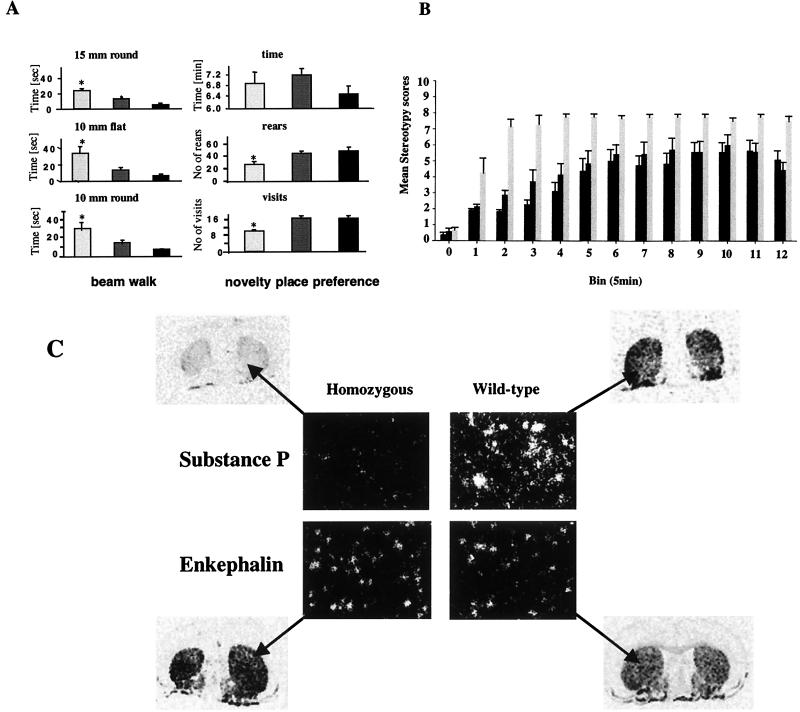FIG. 5.
Motor functioning and dopamine supersensitivity in KA1 mice. (A) Homozygous (light gray bars) and heterozygous (dark gray bars) KA1 mice could not perform as well as their wild-type (black bars) littermates in a beam walking task, but they showed a normal preference for a novel environment. The results, for each beam diameter and shape, are the mean latencies to cross the beam ± SEM of six crossings done by 15 males of each genotype in the fourth (i.e., the final) test session. Data were analyzed by the Tukey-Kramer multiple comparison test, which indicated significant group differences at each level of difficulty (∗, P < 0.05; ∗∗, P < 0.001, compared with the wild-type group [Student t test]). The novelty place preference, assessed using the Tukey-Kramer multiple comparisons test, did not show any significant group differences in the time spent on the novel site. There were, however, significant group differences in the number of visits and rears in the novel environment. The results are represented as mean ± SEM for 15 mice of each genotype. ∗, P < 0.05; ∗∗, P < 0.001, compared with the wild-type group (Student t test). (B) Increased responsiveness to systemically administered d-amphetamine (3 mg/kg) given i.p., on stereotyped behaviors in wild-type, heterozygous, and homozygous animals. Stereotypy ratings, based on the scoring system of Mittleman et al. (23), were taken blind for 1 h postinjection. The lower the rating, the lower the observed rate of stereotypy, and vice versa. The results are the mean scores ± SEM, registered in 12 5-min bins, for 11 wild-type, 8 heterozygous, and 9 homozygous mice. Analysis of variance indicated a significant main effect of group (P < 0.01), consistent with an increased response to d-amphetamine in the homozygous mice. (C) An altered chemical neuroanatomy in the striatum of male VMAT2-deficient KA1 mice expressing substance P and enkephalin mRNA is shown in striatal sections from wild-type mice and homozygous KA1 mutants, hybridized with oligonucleotides complementary to the substance P and enkephalin messages. The relative down-regulation of substance P mRNA expression and the relative up-regulation of enkephalin mRNA expression in the striatum of KA1 homozygous mice was quantified by silver grain counting on mRNA-positive cells. The difference between the two groups was compared by the Student t test and showed a significant difference in the number of silver grains per square millimeter of cell area between wild-type and homozygous mice for both substance P (P < 0.001) and enkephalin (P < 0.05).

